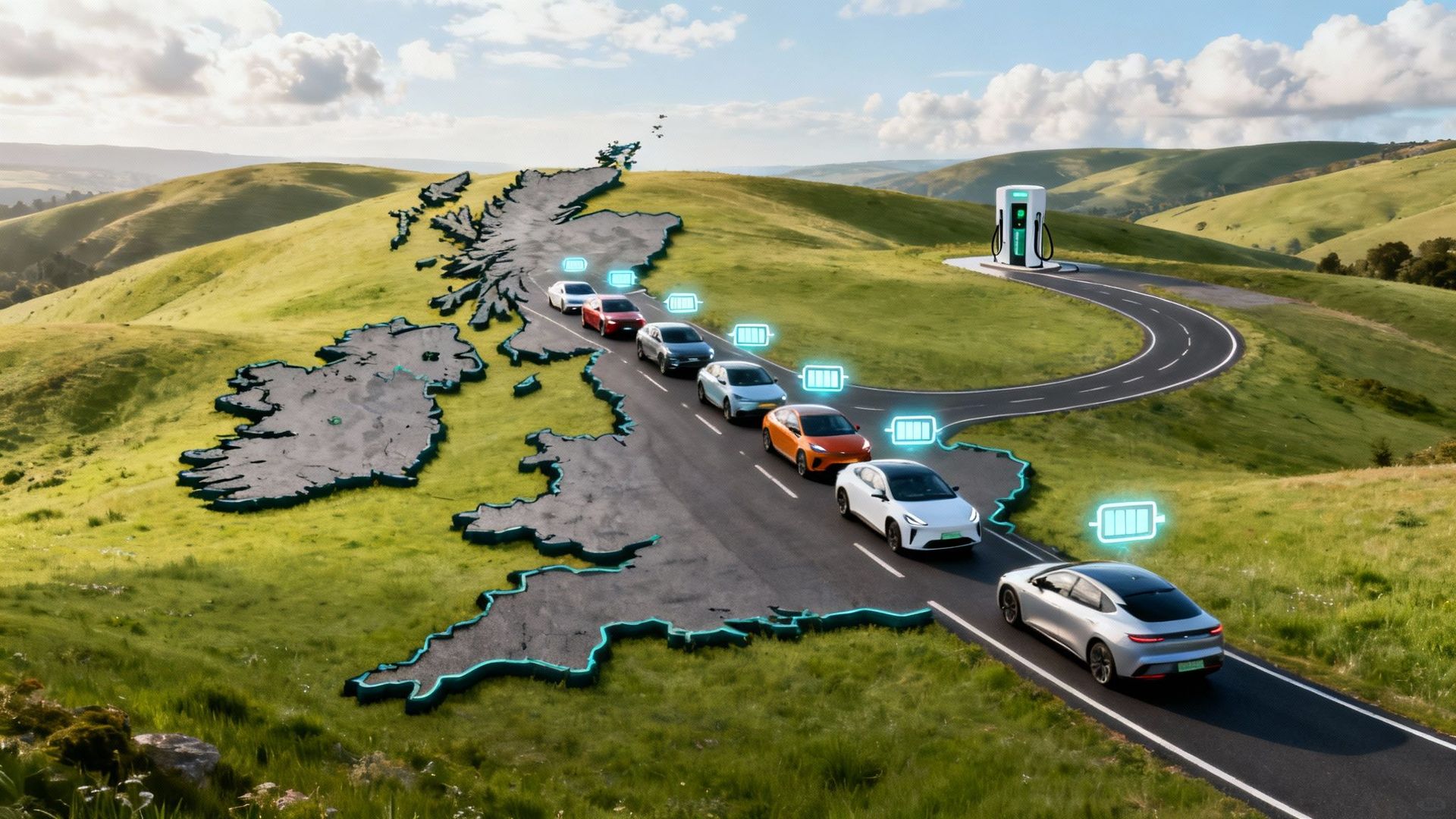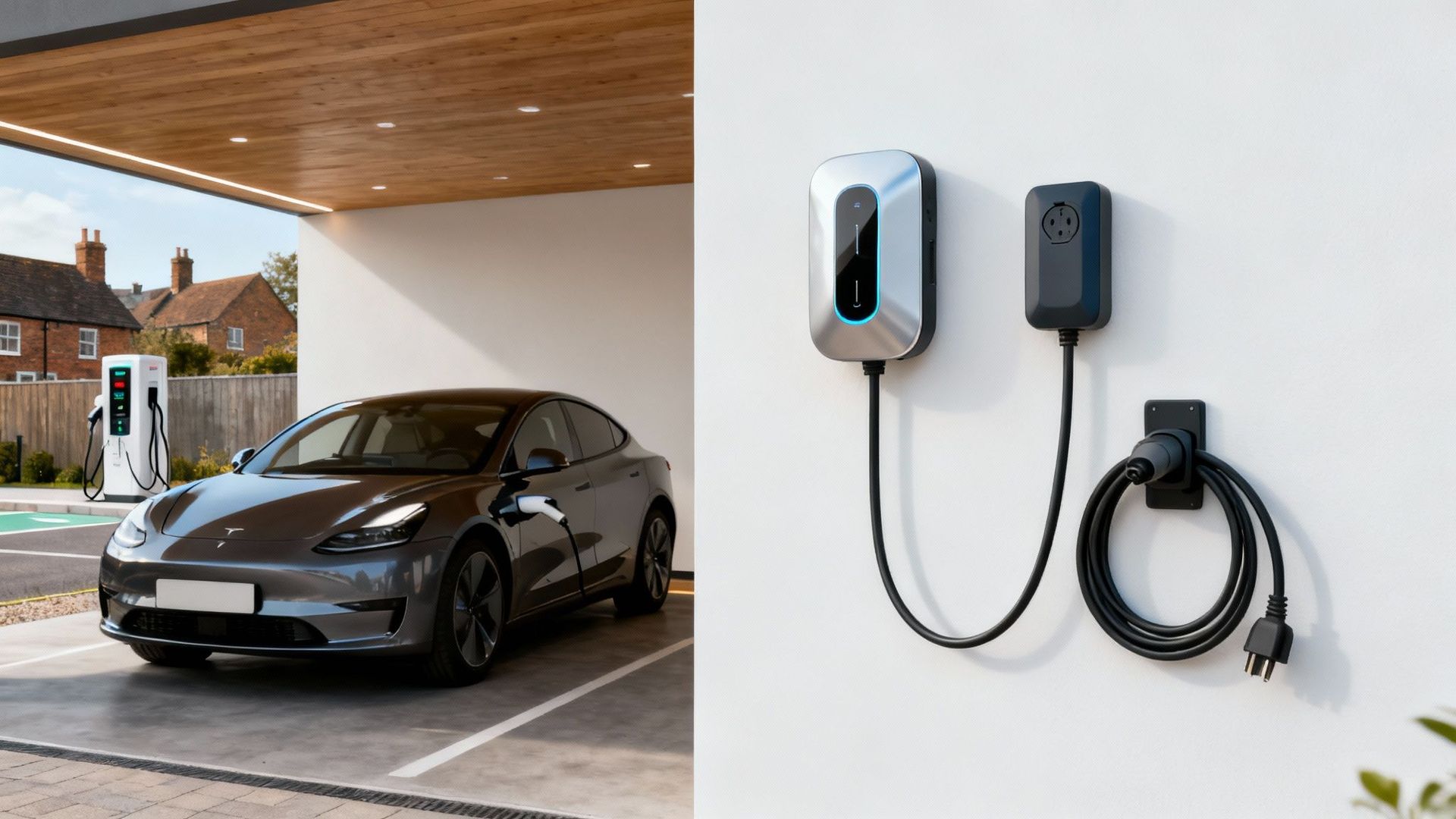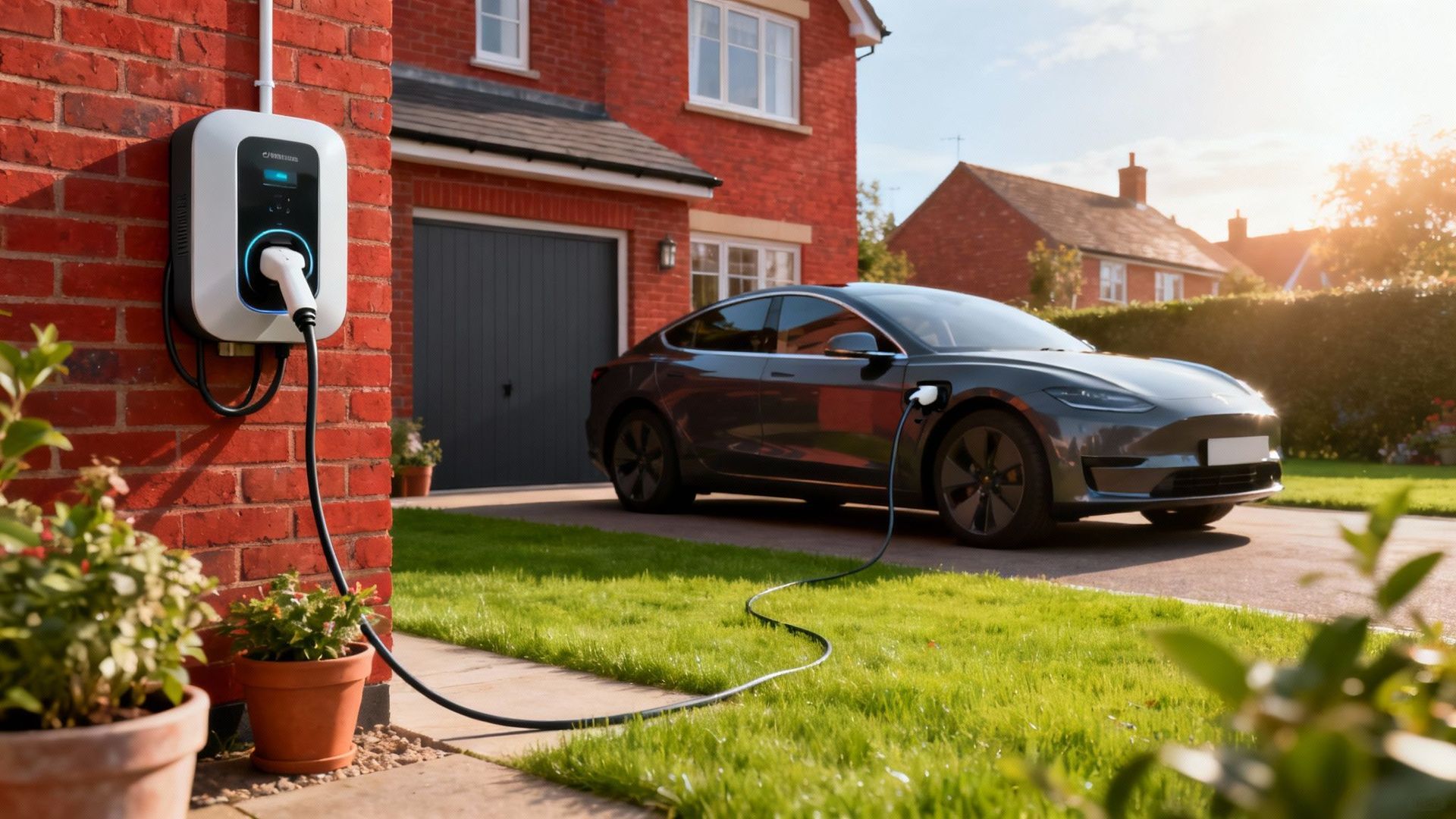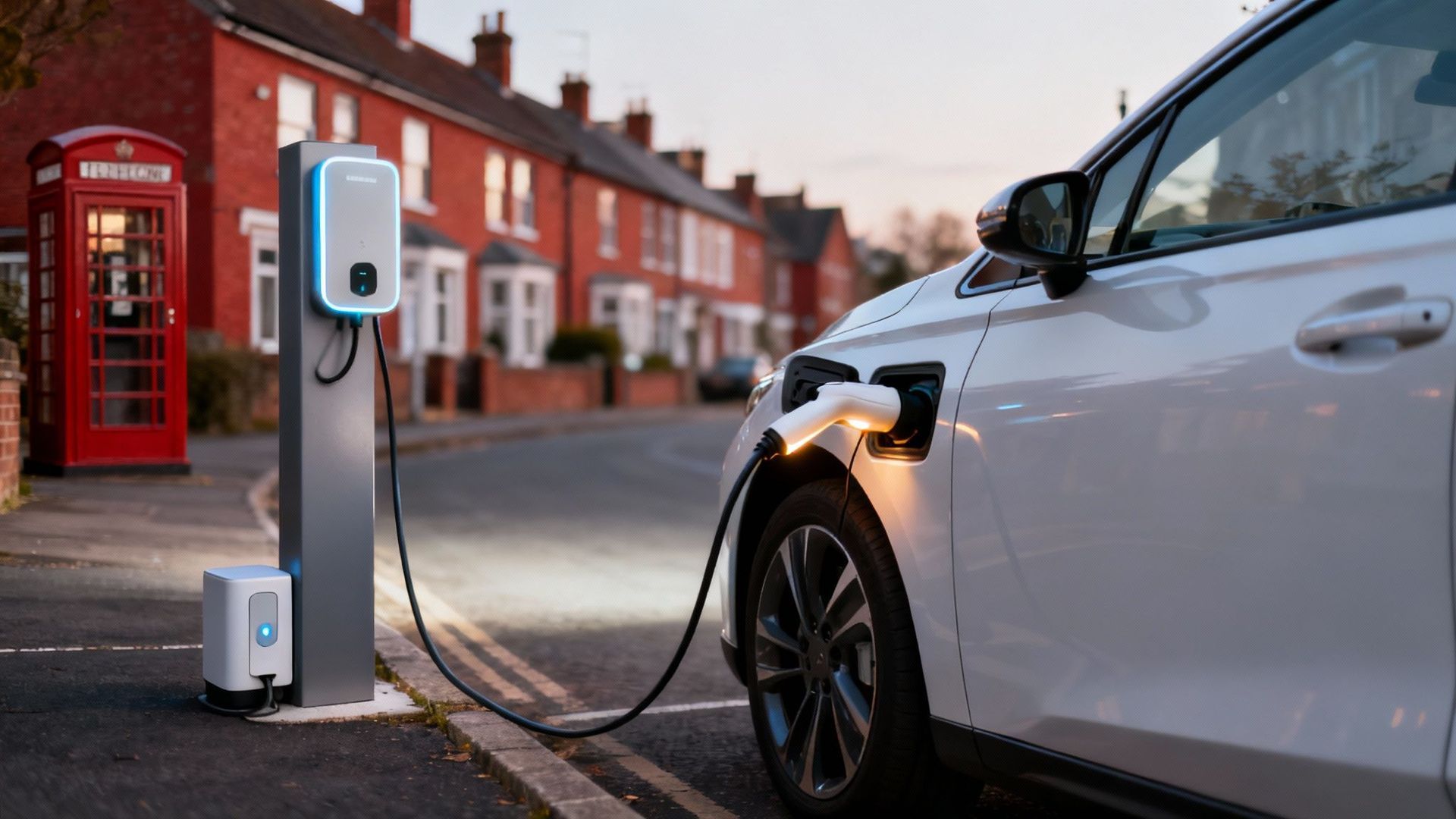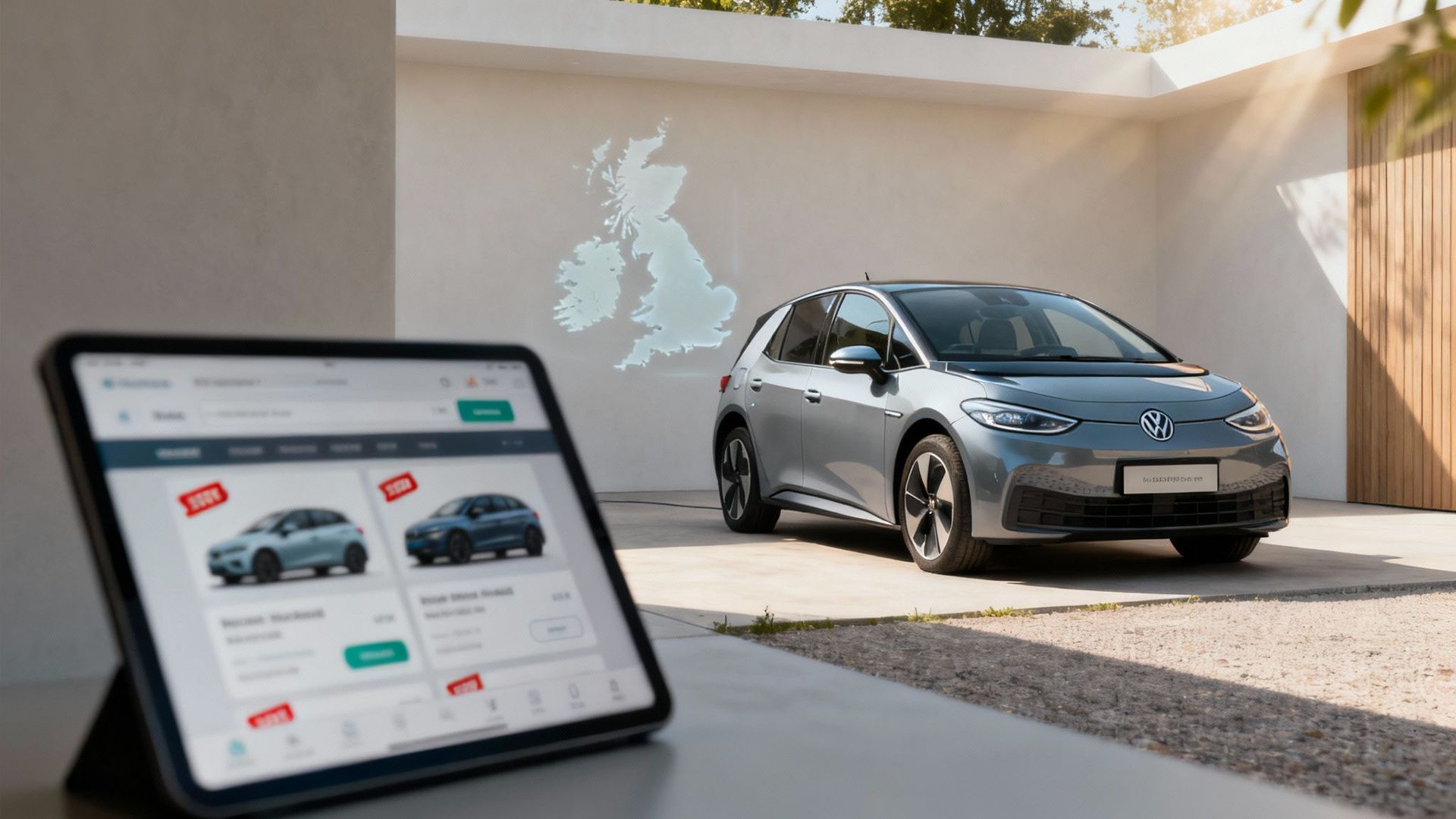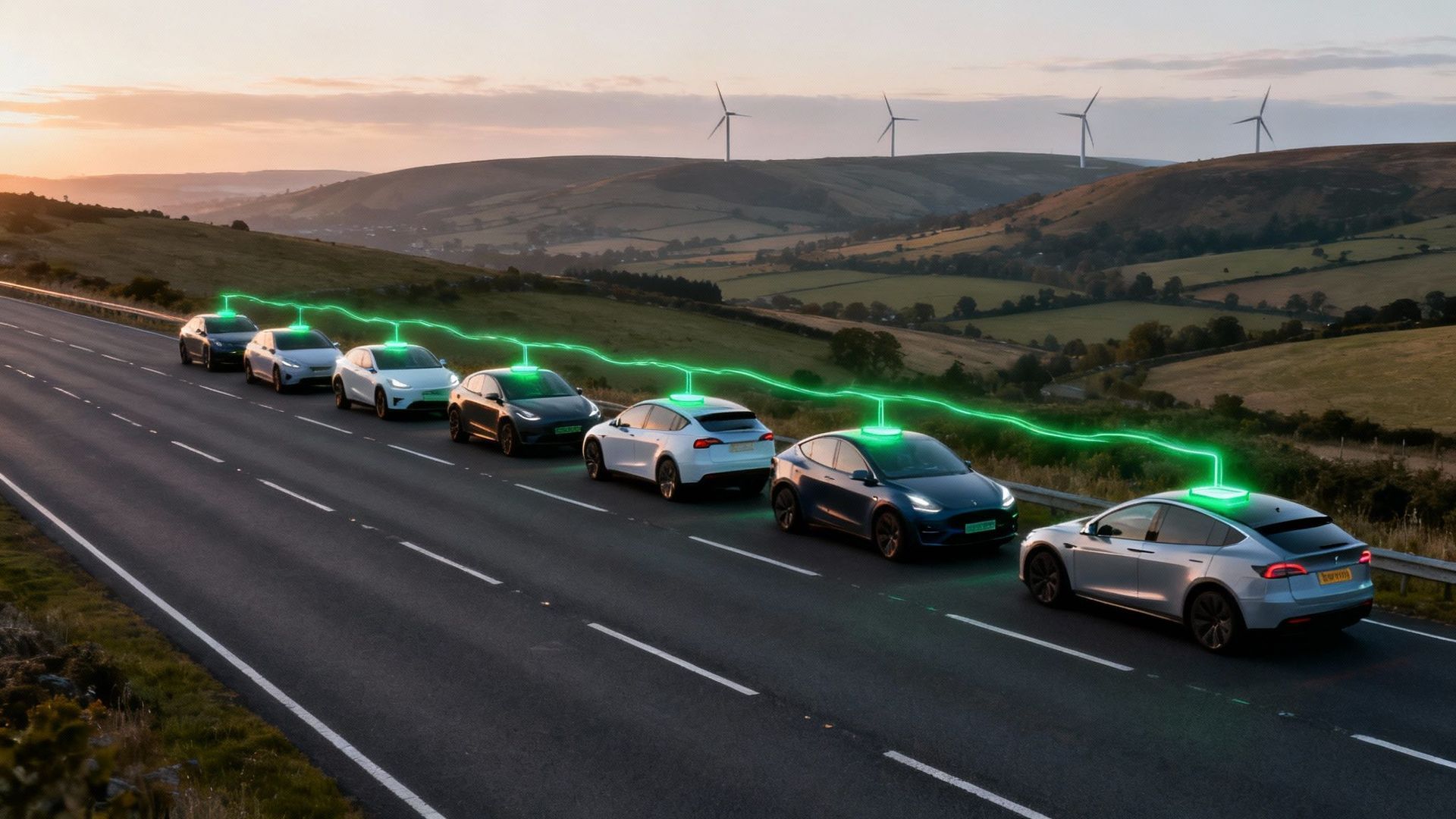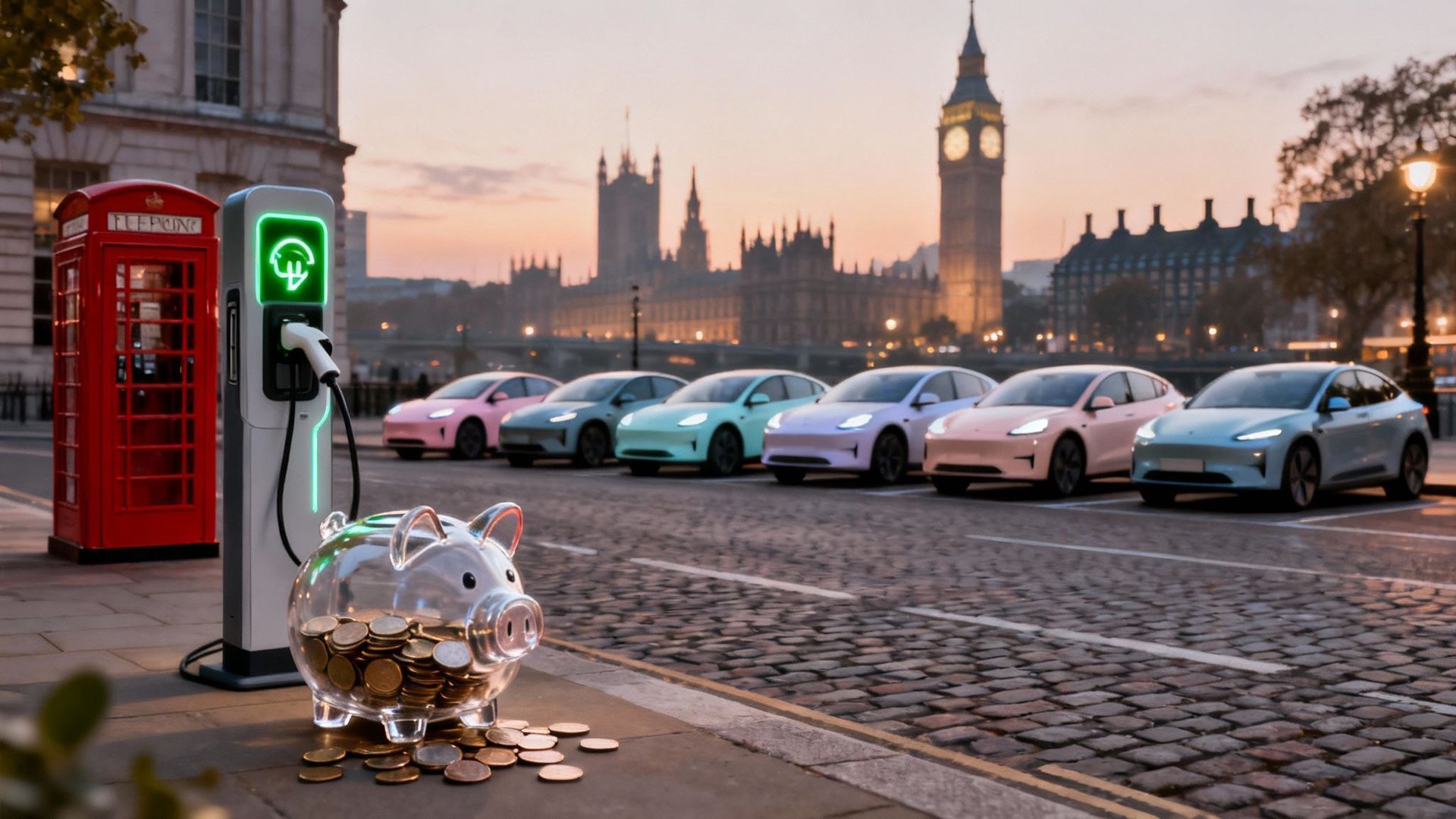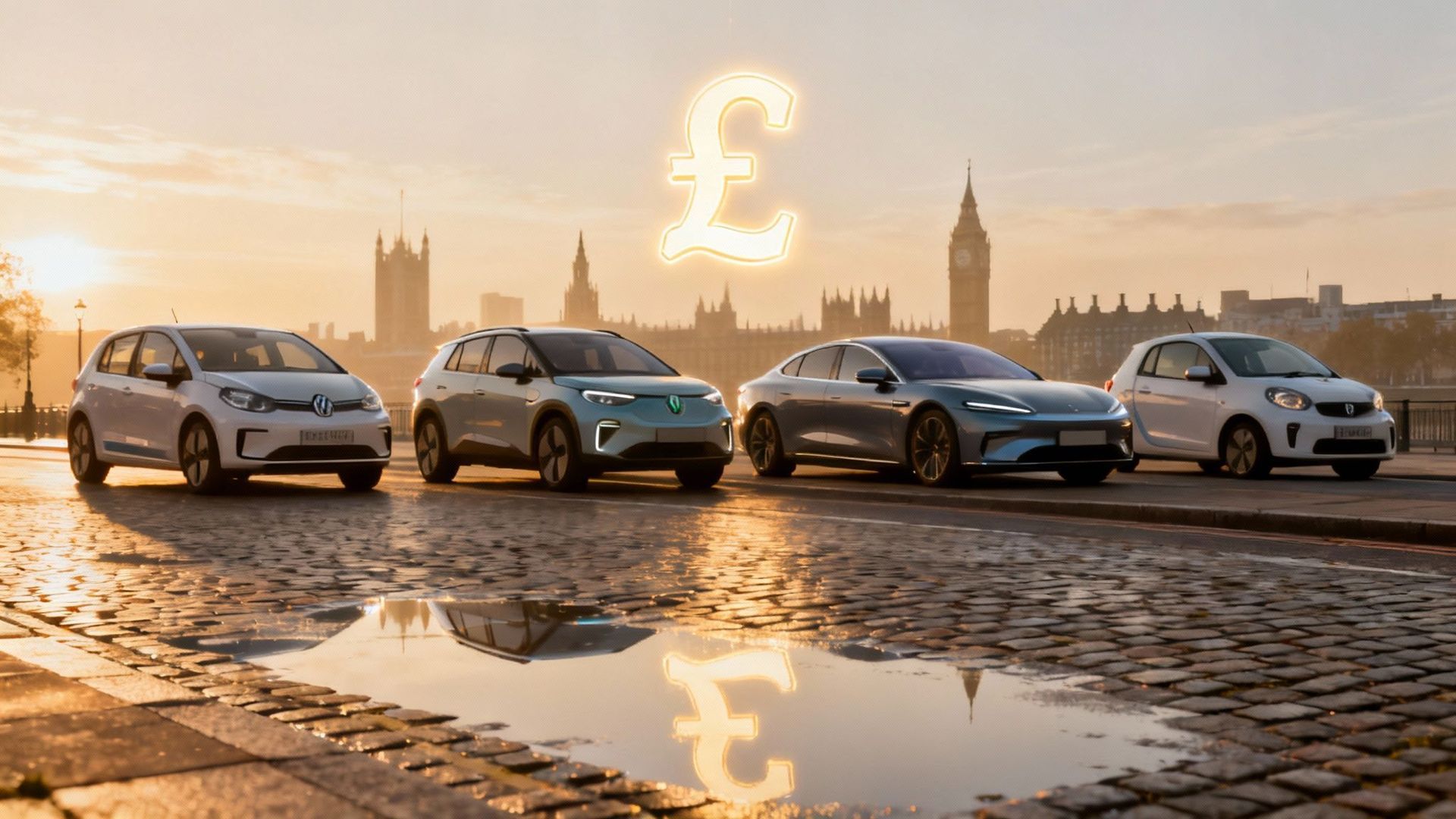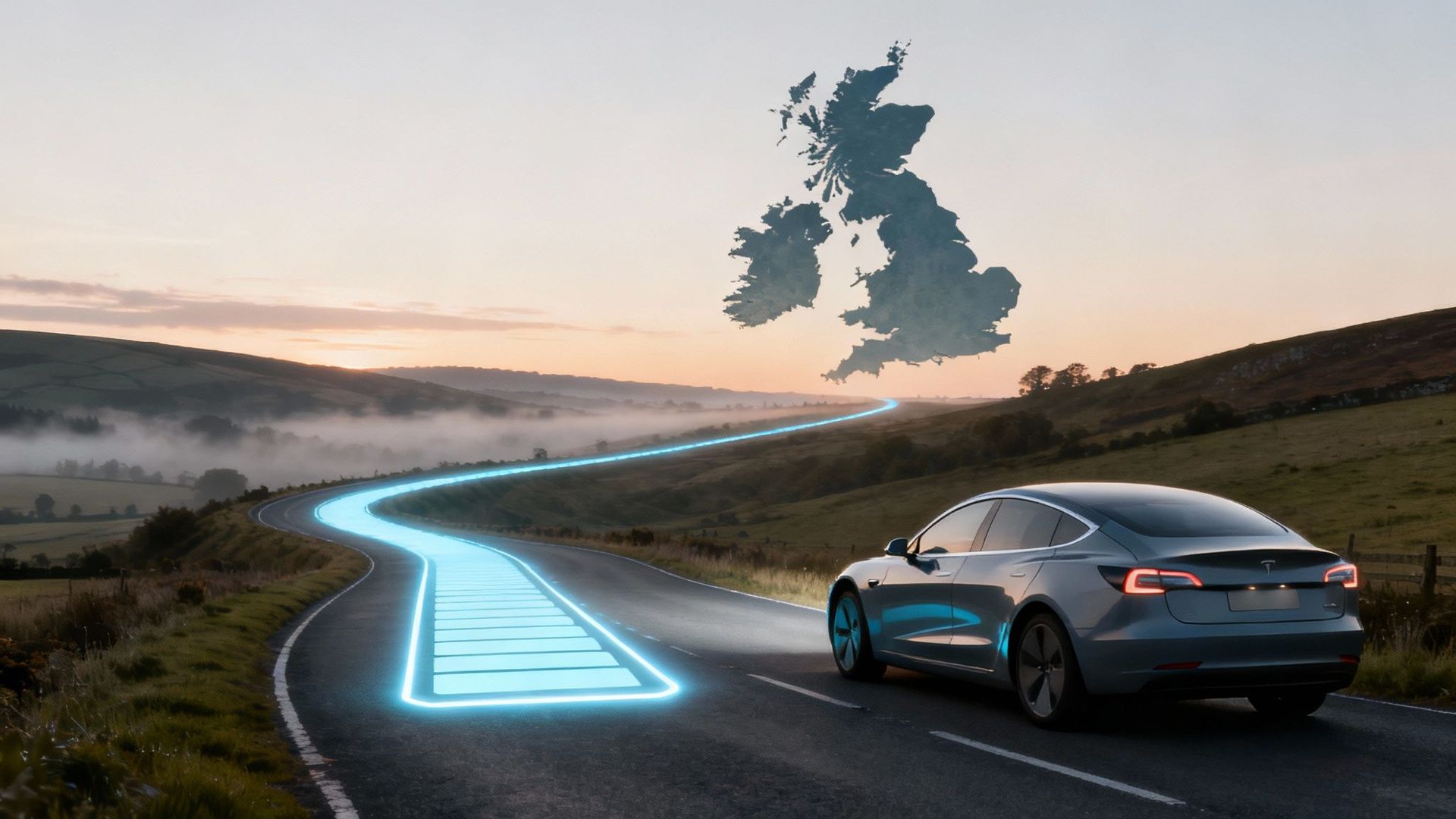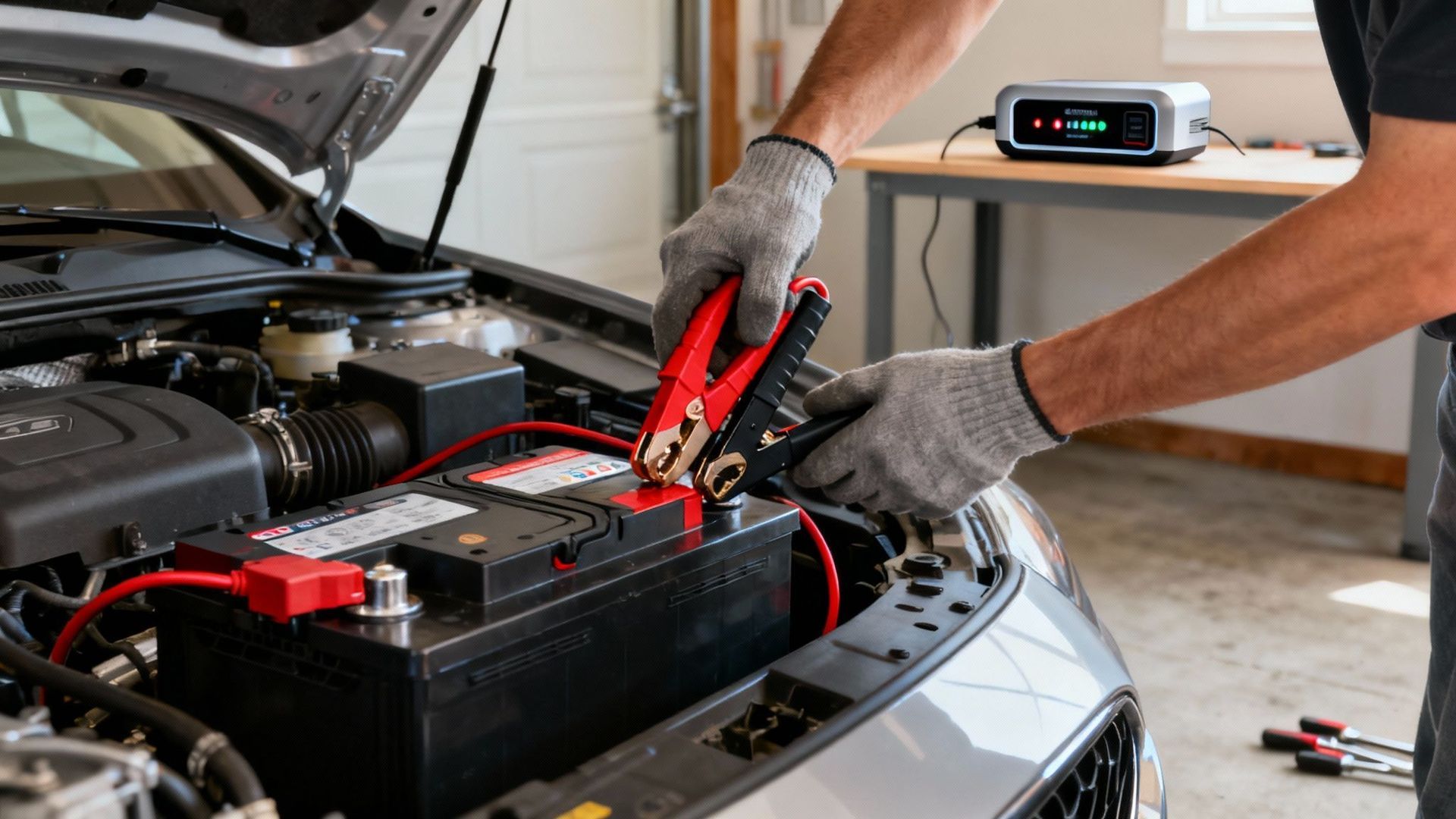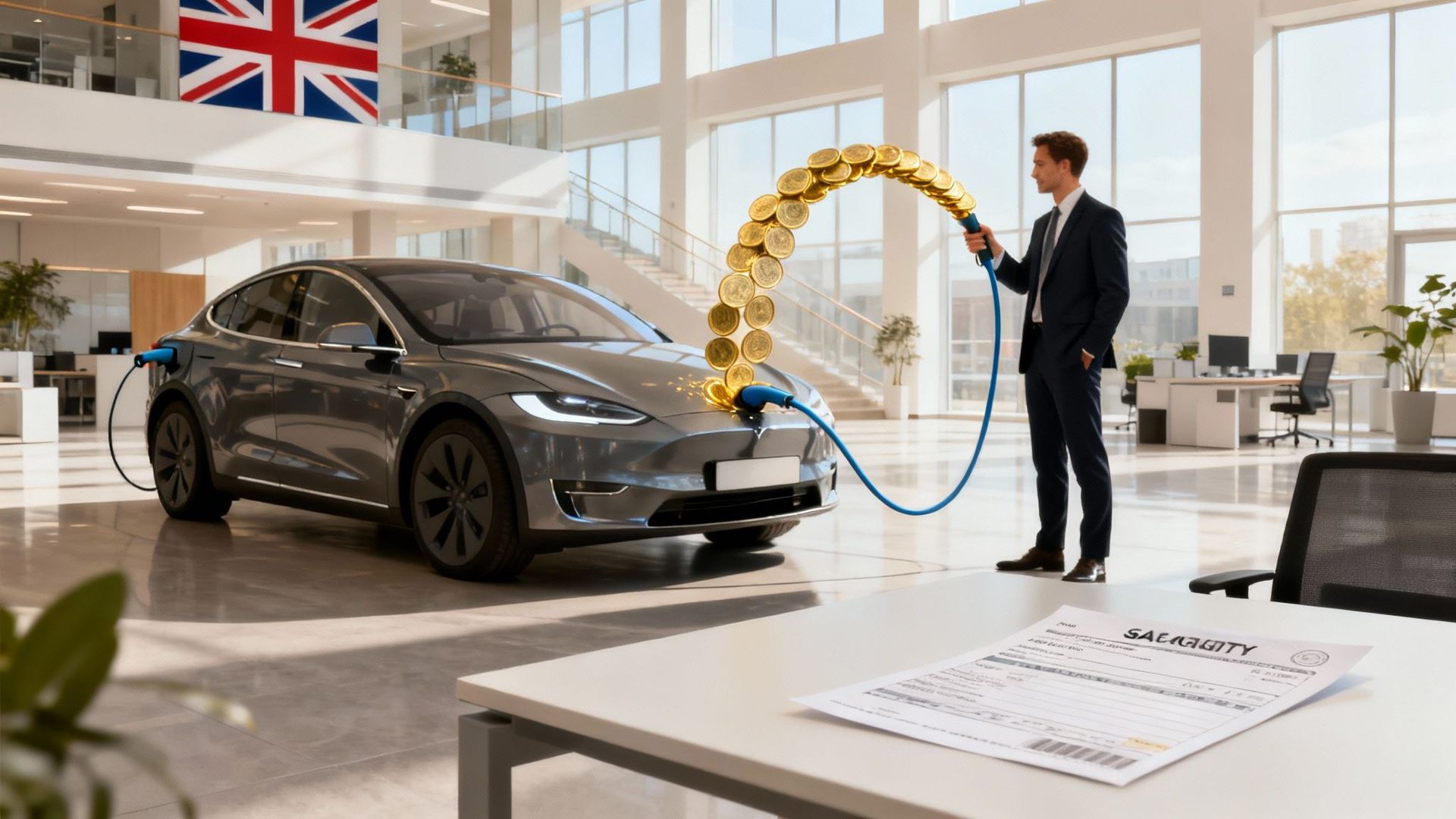The Future of Electric Cars Unplugged
Let's be honest, the switch to electric cars feels less like a choice and more like being told to eat your greens. The future of electric cars isn't some far-off, sci-fi concept anymore. It's barrelling towards us, pushed along by Whitehall deadlines and the sort of relentless marketing that makes you want to go and live in a cave. This is the topic of conversation down the pub, at the garage, and in every car showroom across the UK.
Is the Electric Future Actually Happening?
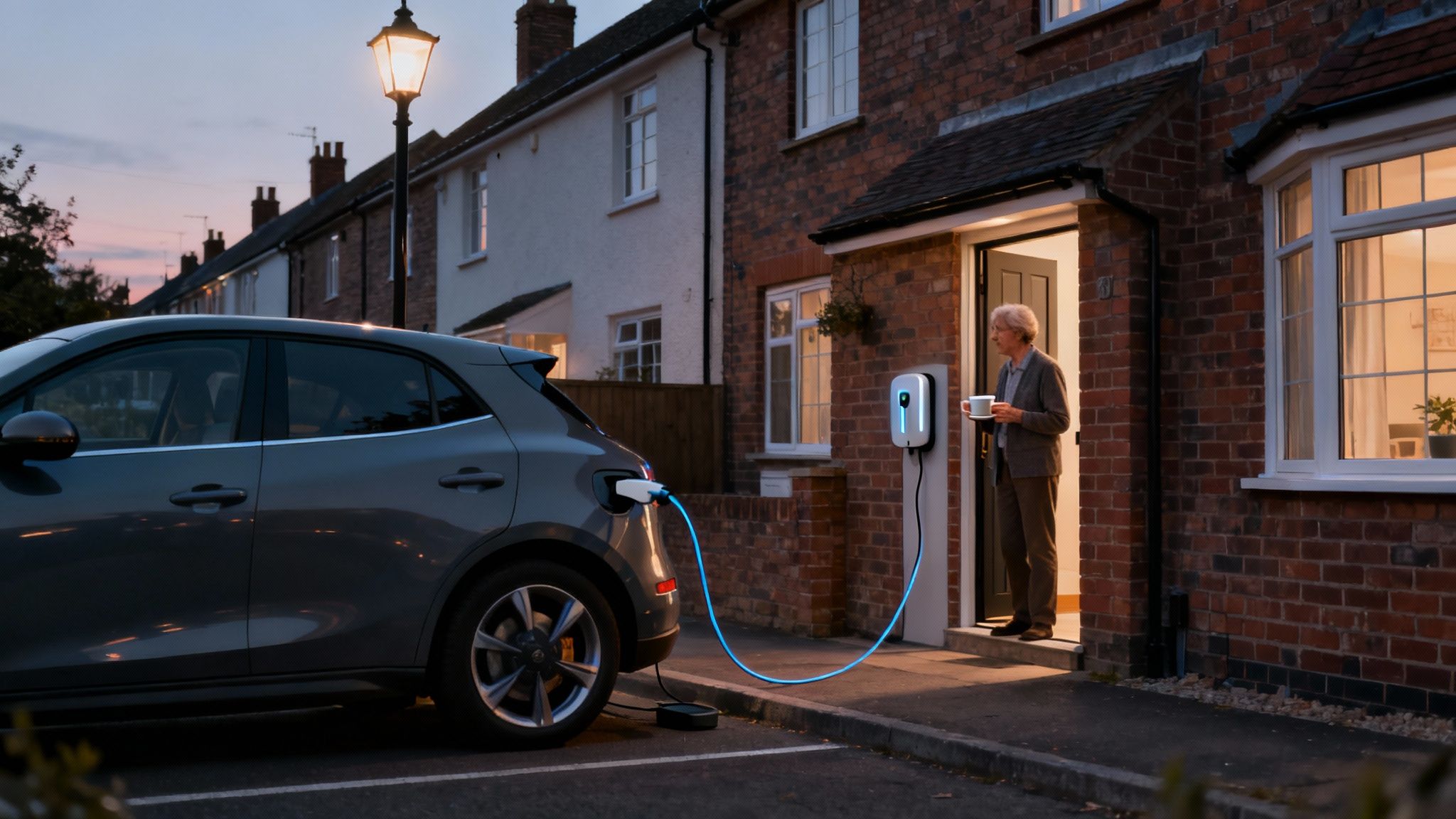
Whether you’re a die-hard petrolhead mourning the glorious racket of a V8 or an early adopter smugly gliding past petrol stations, the shift is undeniable. It's not just hype. The numbers are starting to tell a compelling, if slightly forced, story. This isn't just about saving the planet one silent commute at a time—it's about a fundamental rewiring of what it means to own and drive a car in Britain.
The main driver behind this electric push isn't organic consumer demand, but a firm shove from Westminster. The UK government's plan to ban the sale of new petrol and diesel cars by 2035 has turned the electric transition from a gentle suggestion into a non-negotiable deadline. As a result, battery electric vehicles are grabbing a serious slice of the market. As of August 2023, they held a 15.8% market share of new car registrations across the EU and UK combined, with a year-on-year growth rate of around 30.2% . You can explore more detailed data on electric vehicle registrations to see the trend for yourself.
The Reluctant Revolution
So, what does this actually mean for you, the average punter? It means the conversation has moved from "if" to "when." The sight of your neighbour nervously wrestling with charging cables is becoming more common, and for good reason. The entire industry is twisting itself into new shapes to meet these demands, bringing a mix of genuine progress and some rather inconvenient truths.
This shift involves far more than just swapping a fuel pump for a plug. It's a complete rethink of our relationship with our cars, touching on everything from daily routines to national infrastructure. The questions we're asking are no longer just about horsepower or miles per gallon. Now, the big concerns are:
- Charging Conundrums: Where on earth will everyone plug in, especially the millions of us without a private driveway?
- Battery Lifespan: How long before your car's hugely expensive battery becomes a glorified paperweight?
- The Grid's Big Test: Can our national grid even handle the strain of millions of EVs charging at once, or will the lights go out at 7 pm every evening?
This isn't a utopian vision of silent, clean motoring arriving overnight. It's a messy, complicated, and often frustrating transition, filled with as many compromises as it has promises. The future of electric cars is happening, but it's going to be a bumpy ride.
The Battery Tech Revolutionising Your Next Car
Let's face it, the battery is the heart of every electric car. For years, though, it’s been a bit of a weak one—heavy, ridiculously expensive, and prone to dying at the worst possible moment. It's the single biggest reason EVs carry such a hefty price tag and the root cause of that nagging dread we call ‘range anxiety’.
But the boffins have been hard at work, and the technology they're developing is set to completely change the game for the future of electric cars.
We're not just talking about small, incremental gains, like squeezing an extra 10 miles out of a charge. We are on the verge of a genuine leap forward, moving beyond the current lithium-ion batteries which are basically just a scaled-up version of what’s powering your phone. The next big thing sounds like it's straight out of science fiction: solid-state batteries .
From Soggy Sandwich to Energy Biscuit
So, what on earth is a solid-state battery? The easiest way to think about it is to picture a current EV battery as a soggy sandwich. You’ve got two solid bits of bread (the electrodes) with a gooey, liquid electrolyte sloshing around in the middle. This liquid is heavy, flammable, and it’s the main bottleneck limiting how fast you can shove energy in and get it back out.
A solid-state battery does away with that soggy, liquid centre. It replaces it with a super-thin, solid material. It's like swapping that damp sandwich for a crisp, energy-dense biscuit. This simple-sounding change has huge consequences for performance, safety, and ultimately, cost.
The leap from lithium-ion to solid-state isn’t just an upgrade; it’s a complete reimagining of what an electric car's power source can be. It’s the difference between a hefty, temperamental component and a lighter, safer, and far more powerful heart for your vehicle.
This shift promises a whole host of benefits that could finally make switching to an EV a no-brainer for the average British driver. Imagine an electric car that could travel over 700 miles on a single charge and then top up in about 10 minutes—that's less time than it takes to queue for a coffee at a motorway service station.
The Real-World Payoff
The advantages aren't just theoretical; they translate directly into a better, less stressful driving experience. Here’s a quick rundown of what the solid-state revolution means for you:
- Vanquishing Range Anxiety: With ranges potentially doubling, the fear of getting stranded on the M6 with a dead battery will become a quaint historical anecdote, like worrying about your horse throwing a shoe.
- Lightning-Fast Charging: The solid structure can handle much faster charging speeds without the risk of damage or overheating. Your weekly top-up could soon be as quick as a pit stop.
- Improved Safety: By ditching the flammable liquid electrolyte, solid-state batteries are far less likely to catch fire if they get damaged, making EVs inherently safer.
- Longer Lifespan: These batteries are expected to last for more charge cycles than their liquid-filled counterparts, meaning they'll hold their value better and stay on the road for longer.
This isn't just wishful thinking. Big names like Toyota and Nissan, alongside a whole ecosystem of tech firms, are pouring billions into making this happen. Toyota has been especially vocal, claiming it's on track to have solid-state batteries in its production cars before the decade is out. Of course, you can find a more in-depth discussion by exploring the latest innovations in electric vehicle battery technology right here on our site.
Naturally, there’s a catch. Manufacturing these advanced batteries at scale is fiendishly difficult and expensive right now. The timelines from most carmakers point towards a gradual roll-out, likely starting with high-end luxury models around 2028-2030 . So, while you won’t be picking one up on a cheap lease deal next year, the technology that will define the next generation of electric cars is well and truly on its way.
Solving Britain's Great Charging Problem
So, we’ve established that the batteries powering the future of electric cars are getting a serious upgrade. That’s brilliant news, but it conveniently sidesteps the massive, sparking elephant in the room: charging the things. Right now, finding a working, available public charger can feel like a quest for the Holy Grail, only with more confusing apps and a higher chance of it being blocked by a diesel pickup truck.
For the electric dream to become a daily reality for millions, our charging infrastructure needs to move on from its current state, which can charitably be described as ‘a bit patchy’. Relying on a handful of chargers at a motorway service station simply won’t cut it. The good news is that some genuinely clever solutions are on the horizon, designed to make ‘charger hunting’ a forgotten nightmare.
The future isn't just about sticking more lamppost chargers up or building bigger charging hubs. It's about fundamentally rethinking how we deliver power to our vehicles.
Beyond the Plug Socket
The most ambitious ideas aim to make charging an invisible, passive activity. Imagine never having to consciously plug your car in again. This isn't science fiction; it's the promise of dynamic wireless charging , where pads embedded directly into the road surface charge your car as you drive over them.
Think of it like a giant Scalextric track for grown-ups, but without the risk of your car flying off at the corners. This tech could be deployed on motorways or in dedicated 'e-lanes' in cities, topping up batteries on the move and dramatically reducing the need for long stops. Of course, the sheer cost of digging up and retrofitting thousands of miles of British roads is, to put it mildly, astronomical.
Another contender making a surprising comeback is battery swapping . This concept is brutally simple: instead of waiting for your battery to charge, you pull into a station, and a robot swaps your depleted battery for a fully charged one in minutes. The Chinese firm Nio is already a major proponent of this, operating swap stations across Europe.
The core problem we're trying to solve isn't just about speed; it's about convenience. The goal is to make refuelling an EV as thoughtless and effortless as filling up with petrol, if not more so.
This infographic shows the conceptual leap from current, clunky battery technology to the sleeker, more efficient power sources of the future that will enable these new charging methods.
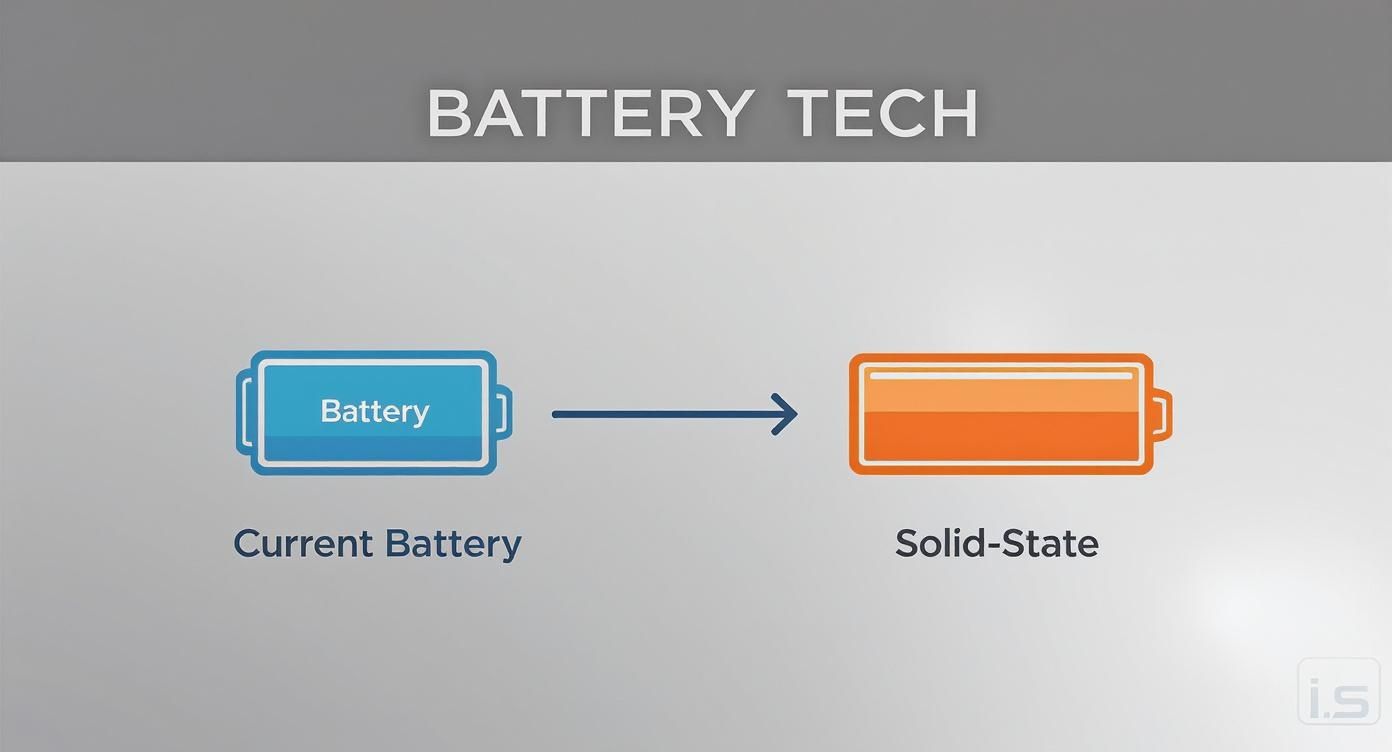
The transition to solid-state batteries will be crucial here. Their smaller size and greater energy density make concepts like rapid swapping and efficient wireless transfer far more viable than they are today.
Future Charging Technologies: A Reality Check
While these ideas are exciting, they face enormous hurdles. We're talking about colossal investment, standardisation across all car manufacturers (a near-impossible task), and a complete overhaul of urban planning. Here’s a quick comparison of what’s coming and the bumps in the road ahead.
| Technology | How It Works (Simply) | Best Case Scenario | Biggest Obstacle |
|---|---|---|---|
| Wireless Charging | Induction pads under the road or in a parking space transfer power to the car. | Drive and park without ever thinking about plugging in. Seamless and convenient. | Eye-watering cost of installation and low efficiency compared to cables. |
| Battery Swapping | Automated stations swap a depleted battery for a full one in under 5 minutes . | "Refuelling" an EV becomes faster than filling a petrol tank. | Requires all carmakers to agree on a standard battery size and shape. |
| Pop-Up Chargers | Kerbside chargers that retract into the pavement when not in use. | Solves street-parking charging without cluttering pavements with posts. | Mechanical complexity and potential for damage from weather or vandalism. |
Ultimately, solving Britain's charging problem will require a mix of all these solutions, not a single silver bullet. You can dive deeper into the current challenges by reading about the EV charging landscape in the UK. Making the transition smooth won’t be easy, but it’s the most critical piece of the puzzle for the future of electric cars.
How AI Is Making Electric Cars Smarter
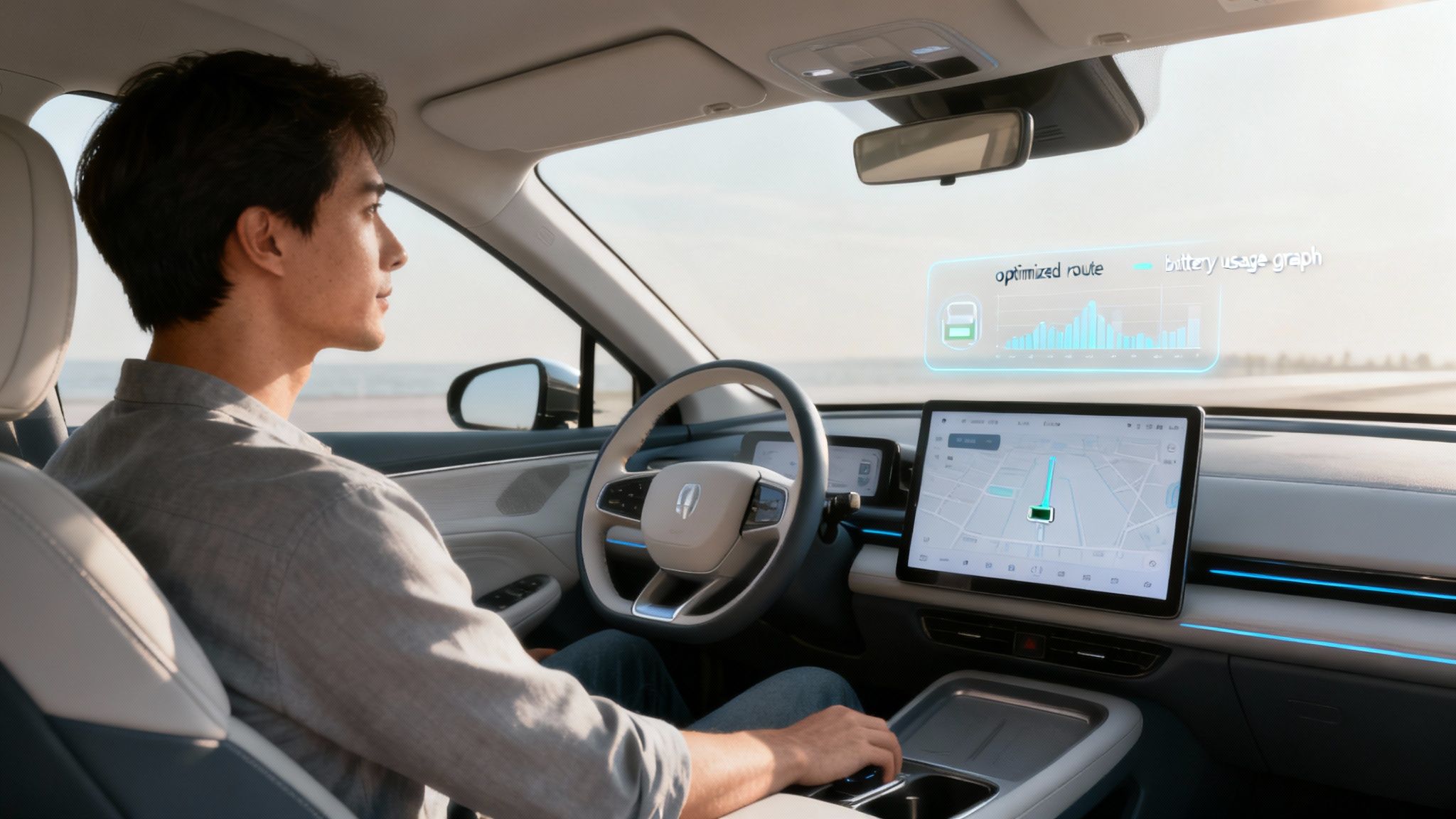
The future of electric cars isn't just about cramming in bigger batteries or slashing charging times. It’s about finally giving them a proper brain. For too long, "smart" car features have been little more than glorified cruise control that throws a wobbly in the rain, paired with an infotainment system that’s as intuitive as assembling flat-pack furniture in the dark.
Thankfully, we’re moving beyond that into the realm of genuine artificial intelligence. AI is poised to completely reshape the driving experience, turning your car from a simple machine into a true co-pilot. This isn't just about asking it to play your terrible '90s pop playlist; it’s about making the vehicle work smarter, not just harder.
Imagine an EV that actually learns your daily commute. It knows you like the scenic route on a Friday and that you always get stuck behind the bin lorry on Tuesdays. By analysing your habits, it can optimise battery usage, pre-condition the cabin before you leave, and suggest the most efficient route based on your unique driving style—not just what a generic algorithm thinks is best.
From Annoying Alerts to Actual Intelligence
The real magic of AI in electric cars lies in its predictive power. Instead of a dashboard light screaming that something has already broken, predictive maintenance will use sensors and data to warn you that a component is about to fail. Think of it as your car having a quiet word: "Alright, mate, that left rear motor is looking a bit tired. Best get it looked at next week before it packs in on the A1."
This proactive approach will save drivers a fortune in surprise repair bills and prevent those dreaded roadside breakdowns. This level of intelligence goes beyond just mechanical parts, too. It will also manage the battery with far more sophistication, learning your charging patterns to preserve its long-term health and efficiency.
But what about the big one? The promise that's been dangled in front of us for years: full autonomy.
Cutting Through the Self-Driving Hype
Let's be brutally honest—the term "full self-driving" has been abused more than a hotel television remote. Most systems available today are, at best, advanced driver aids. They can keep you in your lane and manage your speed, but you are still very much in charge. Having a kip on the M25 during rush hour remains pure fantasy.
To understand where we really are, you need to know about the levels of autonomy:
- Level 3 (Eyes Off): The car handles most driving situations, but you need to be ready to take over at a moment's notice. It’s like supervising a teenager who’s just passed their test.
- Level 4 (Mind Off): The car can drive itself completely within a specific, mapped area (like a city centre). You can genuinely check your emails, but it won't work everywhere.
- Level 5 (Steering Wheel Optional): This is the holy grail. The car can drive itself anywhere, in any condition, without any human intervention whatsoever.
We are currently hovering awkwardly around Level 3, and the leap to Level 4 is proving to be a colossal technical and legal challenge. True Level 5 autonomy is still a very, very long way off.
The real progress in the short term isn't about creating automotive butlers. Instead, AI will subtly improve every aspect of the driving experience, making EVs safer, more efficient, and less of a faff to live with. To get a broader view of what’s coming down the road, you can explore more about the future of EV technology and what to expect in the next decade in our detailed guide. The truly smart car is one that works with you, not just for you.
Who Is Winning the UK Electric Car Race
The electric car shift is shaking up the automotive pecking order faster than anyone expected. For decades, the UK car market was a predictable affair, dominated by a handful of familiar German and British-badged brands. Now, that cosy arrangement has been completely upended. The battle for Britain’s driveways is no longer just between Ford, Volkswagen, and Vauxhall; it's a full-blown international skirmish.
The future of electric cars is being written in real-time on sales charts, and the story is one of serious disruption. Legacy brands are scrambling to pivot from petrol power. Some are managing the transition with grace, while others are flailing spectacularly, like a dad trying to use TikTok. They're pouring billions into electrifying their line-ups, but they're being forced to look over their shoulders at a new, formidable threat.
This new challenge is coming primarily from the East. Brands that were barely a footnote in the UK market just five years ago are now becoming serious contenders, giving the established German marques a massive headache.
The Great Wall of Competition
The meteoric rise of Chinese manufacturers like MG (now Chinese-owned) and BYD (Build Your Dreams) is the biggest story in the UK electric car race. They haven't arrived with experimental curiosities, but with compelling, well-built, and, most importantly, affordable EVs. While some European brands are still figuring out how to make an electric car that doesn't cost the same as a small flat, these new players are already delivering the goods.
They’re winning over British buyers by hitting that sweet spot of price, quality, and a generous list of standard equipment that would make a premium German brand blush. This isn't just a niche movement; it's a mainstream takeover in progress. The numbers speak for themselves, showing a market that's hungry for new options.
The old guard can no longer rely on brand loyalty alone. When a new player offers a car that’s just as good—or better—for thousands of pounds less, badges start to matter a whole lot less.
This surge in competition is fantastic news for the average car buyer. It’s forcing everyone to up their game, which leads to better products and, crucially, more competitive pricing. The days of a limited, expensive pool of EV choices are rapidly coming to an end.
The Numbers Don't Lie
This market upheaval is vividly reflected in the registration figures. The UK's appetite for electric cars continues to grow, fuelling this competitive frenzy. In September 2023 alone, battery electric vehicle (BEV) registrations surged to 72,779 , a 29.1% jump from the previous year. This gave electric cars a 23.3% share of the new car market for that month.
When you add in hybrids, electrified vehicles accounted for over half of all new vehicle registrations in the UK. You can explore more of the European EV sales trends to see the full picture.
So, who is actually winning? It’s a mixed bag.
- The Upstarts: Brands like MG and BYD are posting huge percentage gains, rapidly building their market share from a low base.
- The Legacy Players: Mainstays like Volkswagen, Audi, and BMW are still selling plenty of EVs in raw numbers, but they're fighting harder than ever to maintain their dominance.
- The Innovators: Tesla continues to be a major force, often topping the sales charts with its Model Y, proving that its early lead still counts for a lot.
The real winner, for now, is the consumer. This fierce competition means more choice, better technology, and downward pressure on prices—three things the car market has desperately needed for years.
Our Verdict on the Future of Electric Cars
So, after wading through all the battery jargon, infrastructure promises, and the corporate scrap for market share, what's the real verdict on the future of electric cars? Are we heading for a gleaming, silent utopia, or are we just trading the smell of petrol for the low hum of charger anxiety? The truth, as is often the case, lies somewhere in the messy middle.
The shift is well and truly underway, regardless of how you feel about it. But forget the slick marketing visions of cars that drive themselves while we snooze. The reality for the average UK driver over the next five to ten years will be far more down-to-earth. It's a future that involves compromises, yes, but also one of very real progress.
This electric transition isn't one single, tidy event. It's more of a chaotic mash-up of brilliant battery breakthroughs, AI that is slowly getting less daft, and a charging network that’s still desperately playing catch-up.
The Road Ahead: A Realistic Preview
Let’s get one thing straight: the electric future isn’t going to solve all our transport woes. We’ll still get stuck in traffic jams on the M25, only now our cars will be silently draining their batteries instead of noisily burning fuel. Still, some changes are undeniable, and most of them are for the better.
- Better, Cheaper Cars: Fierce competition, particularly from new brands entering the market, is driving prices down and pushing quality up. Your next EV will almost certainly be cheaper to buy, go further on a charge, and be packed with more tech than you know what to do with.
- Smarter, Not Just Faster: The real progress is happening behind the scenes. AI-driven battery management will eke out more miles from every charge, and predictive maintenance will flag small problems before they become big, expensive ones.
- Charging Gets Less Awful: While we won't be charging wirelessly on the motorway anytime soon, the day-to-day experience is set to improve. More reliable, faster charging hubs will become the norm, even if finding one on a wet Tuesday in Stoke remains a bit of a lottery for a while yet.
The market is certainly reflecting this momentum. Sales figures show a relentless upward curve, with battery electric vehicles hitting a record 20.2% market share across Europe in the first eight months of 2023. That represents a whopping 27% year-over-year increase in sales. You can dig deeper into the expanding European EV market to see how the numbers are stacking up across the continent.
Ultimately, the future of electric cars hinges on one simple question: will they deliver a better driving experience for the rest of us? Not just for the early adopters or the tech evangelists, but for the person doing the school run, the weekly shop, or the long-haul holiday trip.
The answer, viewed with a healthy dose of British cynicism, is leaning towards a qualified ‘yes’. It won’t be perfect, and there will be frustrating moments. But the core technology is improving at a blistering pace. The cars themselves are becoming undeniably good to drive—they're quiet, ridiculously quick, and cheaper to run.
Once the infrastructure finally catches up with the vehicles, owning an EV might just become the sensible, convenient, and even enjoyable choice for everyone. And that, more than any government target, will be the true sign that the electric future has finally arrived.
Your EV Questions Answered
Right, let's tackle some of the nagging questions you've probably been shouting at the telly. The future of electric cars is surrounded by a fog of marketing spiel and pub myths, so let's cut through the nonsense and get some straight answers.
Will Electric Cars Ever Be as Cheap as Petrol Cars?
Ah, the million-dollar question—or rather, the thirty-thousand-pound question. Right now, the upfront cost of an EV can make your wallet weep, and that's a genuine barrier for many. But the magic word here is parity .
Most experts reckon we’ll hit price parity, where a new EV costs the same as its petrol equivalent, somewhere between 2025 and 2027 . This isn't just wishful thinking; it's being driven by a few key factors. Battery costs are plummeting, manufacturing is getting more efficient as production ramps up, and fierce competition from new brands is forcing everyone to get more competitive with their pricing.
Once you factor in the lower running costs—no road tax, cheaper "fuel" from your home socket, and far less maintenance—the total cost of ownership is already a winning formula for many models. The days of EVs being exclusively for the well-heeled are numbered.
How Long Will an EV Battery Really Last?
The fear of your car’s monstrously expensive battery giving up the ghost after a few years is a big one. Relax. It’s not like your phone battery, which seems to lose half its life after a year. EV batteries are built for the long haul.
Most manufacturers offer a warranty of around eight years or 100,000 miles , guaranteeing the battery will retain at least 70% of its original capacity. In the real world, modern EV batteries are proving to be incredibly durable. Evidence shows they easily outlast the car itself, so you'll likely want a new car long before the battery packs it in.
Don't think of an EV battery as a disposable item. It's a robust, long-term component designed for hundreds of thousands of miles of service, making the fear of sudden, catastrophic failure largely unfounded for modern vehicles.
What Happens to All the Old Batteries?
This is a genuinely important point. The image of mountains of dead batteries poisoning the earth isn't a great look for a supposedly green technology. Thankfully, this is something the industry is taking very seriously.
An EV battery is far too valuable to just be chucked away. When it's no longer suitable for a car (i.e., drops below that 70% capacity mark), it enters a new phase of life.
- Second-Life Applications: Old batteries are perfect for stationary energy storage. Think of them being used to store solar power for homes or helping to balance the national grid during peak demand.
- Recycling: When a battery truly is at the end of its life, it's broken down, and the valuable materials inside—like lithium, cobalt, and nickel—are recovered. Recycling technology is improving rapidly, with the goal of creating a "closed-loop" system where old batteries provide the raw materials for new ones.
The aim is to create a circular economy where very little is wasted, ensuring the future of electric cars is as sustainable as promised.
For more no-nonsense reviews, industry news, and guides on making the switch to electric, check out all the content here at VoltsMonster . We're your go-to source for demystifying the EV world. Explore our latest articles and deals at https://www.voltsmonster.com.

